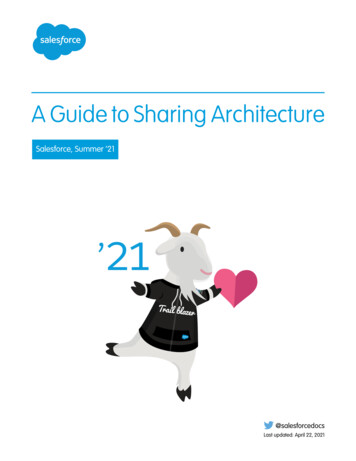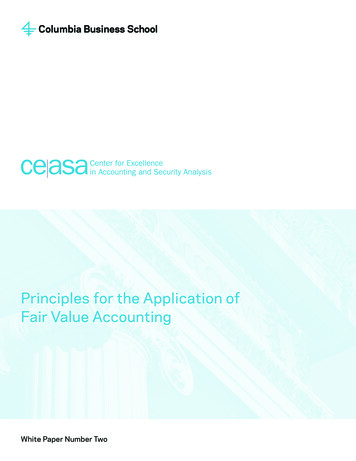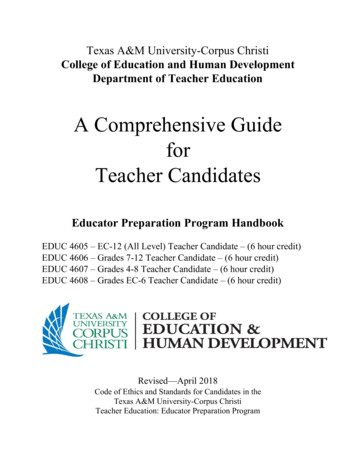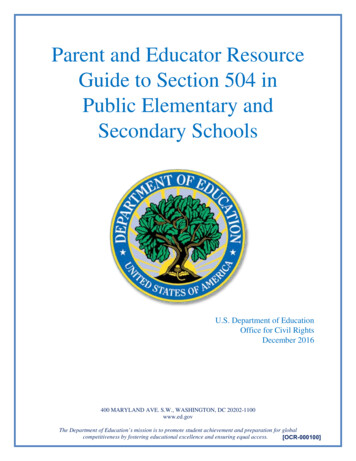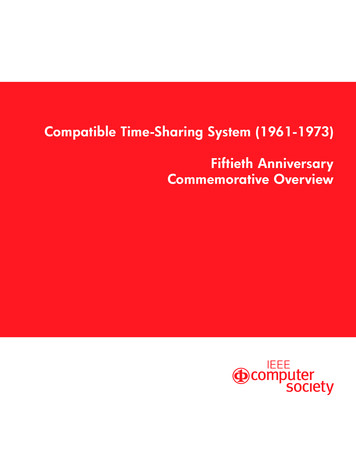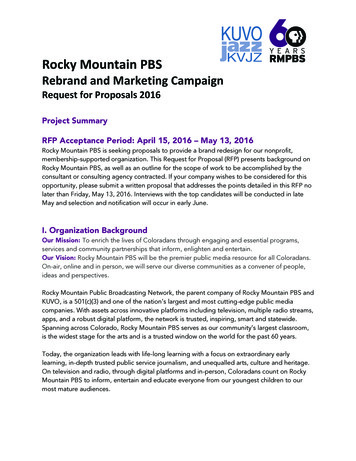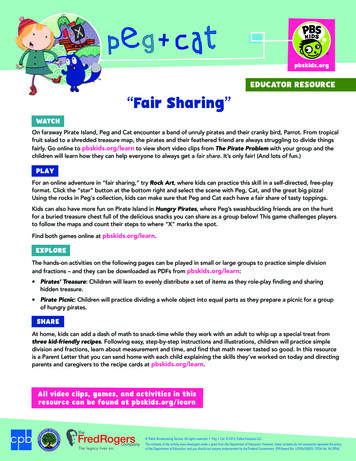
Transcription
pbskids.orgEDUCATOR RESOURCE“Fair Sharing”WATCHOn faraway Pirate Island, Peg and Cat encounter a band of unruly pirates and their cranky bird, Parrot. From tropicalfruit salad to a shredded treasure map, the pirates and their feathered friend are always struggling to divide thingsfairly. Go online to pbskids.org/learn to view short video clips from The Pirate Problem with your group and thechildren will learn how they can help everyone to always get a fair share. It’s only fair! (And lots of fun.)PLAYFor an online adventure in “fair sharing,” try Rock Art, where kids can practice this skill in a self-directed, free-playformat. Click the “star” button at the bottom right and select the scene with Peg, Cat, and the great big pizza!Using the rocks in Peg's collection, kids can make sure that Peg and Cat each have a fair share of tasty toppings.Kids can also have more fun on Pirate Island in Hungry Pirates, where Peg’s swashbuckling friends are on the huntfor a buried treasure chest full of the delicious snacks you can share as a group below! This game challenges playersto follow the maps and count their steps to where “X” marks the spot.Find both games online at pbskids.org/learn.EXPLOREThe hands-on activities on the following pages can be played in small or large groups to practice simple divisionand fractions – and they can be downloaded as PDFs from pbskids.org/learn: Pirates’ Treasure: Children will learn to evenly distribute a set of items as they role-play finding and sharinghidden treasure. Pirate Picnic: Children will practice dividing a whole object into equal parts as they prepare a picnic for a groupof hungry pirates.SHAREAt home, kids can add a dash of math to snack-time while they work with an adult to whip up a special treat fromthree kid-friendly recipes. Following easy, step-by-step instructions and illustrations, children will practice simpledivision and fractions, learn about measurement and time, and find that math never tasted so good. In this resourceis a Parent Letter that you can send home with each child explaining the skills they’ve worked on today and directingparents and caregivers to the recipe cards at pbskids.org/learn.All video clips, games, and activities in thisresource can be found at pbskids.org/learn Public Broadcasting Service. All rights reserved. Peg Cat: 2013, Feline Features LLC.The contents of this activity were developed under a grant from the Department of Education. However, those contents do not necessarily represent the policyof the Department of Education, and you should not assume endorsement by the Federal Government. [PR/Award No. U295A100025, CFDA No. 84.295A]
pbskids.orgDear Parent,Today, your child practiced “fair sharing” with Peg and Cat, the problem-solving, math-loving duo fromPBS KIDS. Be sure to ask your child about the game(s) we played to share a snack and buried treasurewith a band of unruly pirates. When we learned about “fair sharing,” we were really practicing simpledivision and fractions, as the children worked to evenly distribute a set of items and divide a wholeobject into equal parts. You can encourage your child to continue exploring these and other early mathconcepts online at pbskids.org.At home, you and your family can join in the fun by making kid-friendly treats from Peg Cat recipecards. Choose from three simple recipes with step-by-step instructions and illustrations, and your childwill practice simple division and fractions, learn about measurement and time, and have lots of yummymath fun. You can find instructions at pbskids.org/learn under “Fair Sharing.”Learning math skills at a young age is important, so that children can succeed in school and in life.Peg Cat makes math fun! Your family can watch the show weekdays on your local public televisionstation and anytime at pbskids.org/peg.Estimados padres:El día de hoy, su hijo practicó el aprender a compartir con Peg y Cat, el dúo de personajes de PBS KIDS, a quienesles fascinan las matemáticas y resolver problemas. Pregunte a su hijo sobre el (los) juego(s) que jugamos sobrecompartir alimentos y enterrar un tesoro con un grupo de piratas indisciplinados. Al aprender a compartir, enrealidad estuvimos practicando la división simple y las fracciones, ya que los niños trabajaron en dividir y distribuiren partes iguales un conjunto de objetos y dividir un objeto entero en partes iguales. Usted puede motivar a su hijoa que continúe explorando estos y otros conceptos básicos de matemáticas en línea en pbskids.org.En casa, usted y su familia pueden unirse a la diversión con los platillos simples para niños utilizando las recetas dePeg Cat. Elijan entre tres recetas simples con ilustraciones e instrucciones paso a paso. Al mismo tiempo, ustedy su hijo estarán practicando la división simple y las fracciones, aprenderán sobre medidas y tiempo, y tendránmucha diversión deliciosa utilizado las matemáticas. Usted puede encontrar instrucciones en pbskids.org/learn;sección “Fair Sharing.”Aprender habilidades matemáticas a una edad temprana es importante para que los niños tengan éxito en el colegioy en la vida cotidiana. ¡Peg Cat hacen las matemáticas más divertidas! Su familia puede ver los programas detelevisión en su estación de televisión pública entre semana y en cualquier momento en línea en pbskids.org/peg. Public Broadcasting Service. All rights reserved. Peg Cat: 2013, Feline Features LLC.The contents of this activity were developed under a grant from the Department of Education. However, those contents do not necessarily represent the policyof the Department of Education, and you should not assume endorsement by the Federal Government. [PR/Award No. U295A100025, CFDA No. 84.295A]
pbskids.orgACTIVITY#Pirates’ TreasureChildren will learn to evenly distribute a set of items as theyrole play finding and sharing pirates’ treasure.LEARNING GOALSITEMS NEEDED Count by ones up to 12 Sharing Stories (attached) Separate a set of up to 12 objects intotwo or three equal groups 12 small objects to serve as “treasure”such as pennies, beads, or coins Practice estimating and problem solvingGET READYView video clips from The Pirate Problem with yourgroup at pbskids.org/learn and review the conceptof fair sharing: sharing a group of objects so that eachperson has the same number.HAVE FUN!1. Gather a small group of children and tell themyou are going to pretend to be pirates! Selecttwo children and tell everyone that these twopirate friends have found a buried treasure.Show them the pile of treasures, and with thechildren, count them one by one.2. Oh no! There’s a BIG PROBLEM! There aretwo pirates and 12 treasures! How can youshare the treasure so that they each get thesame amount – a “fair share”? Invite thechildren to brainstorm a solution.3. Demonstrate fair sharing by giving onetreasure to each pirate. “One for you and onefor you. It’s fair!”4. Continue sharing the treasures until they haveall been given out. “Two for you and two foryou. Three for you and three for you.”5. Pose this question: “How many treasures dideach pirate get?” Count the treasures foreach pirate. Touch each treasure as youcount, “One two three.” Check to makesure each pirate received the same number.(continued)All video clips, games, and activities in thisresource can be found at pbskids.org/learn Public Broadcasting Service. All rights reserved. Peg Cat: 2013, Feline Features LLC.The contents of this activity were developed under a grant from the Department of Education. However, those contents do not necessarily represent the policyof the Department of Education, and you should not assume endorsement by the Federal Government. [PR/Award No. U295A100025, CFDA No. 84.295A]
pbskids.orgACTIVITY#Pirates’ TreasureHAVE FUN!(continued)(cont.)6. Summarize: “Wow! We had 12 treasures. When8. You may wish to use this opportunity to intro-we shared them between two pirates, theyeach got six. It’s fair!” You may want to countout the treasures again, to reinforce theconcept.7. Now demonstrate a scenario using more thantwo pirates. When there are three pirates, eachget four treasures. If there are four pirates,each will get three. If there are six, each willget two. The same counting strategy (“one foryou, one for you”) will work regardless of howmany pirates there are.PROBLEM SOLVED!duce related vocabulary. You can explain thatwhen you “share” a group of items, you are“dividing” it into smaller groups. A “fair share”means an “equal” amount for each person.9. Now, take out the sharing stories and invitea child pick out a story card. Read the storyaloud and have the children act out the skit.Ask them to explain out loud how they aredividing up the treasure. Continue until allthe cards are gone.ANOTHER FUN IDEAWhen the treasures have all been shared fairly,sing the “Problem Solved” song!Problem solved! The problem is solved!We solved the problem! Problem solved!Invite the children to make up their own sharingstories! Encourage the children with questionssuch as, “Where did you find the buried treasure?What is inside the treasure chest? How manypirates need to share it? How much treasure willeach pirate get?” If a child creates a story problemthat does not work out evenly, introduce theconcept of remainder. Emphasize that eachperson must get a fair share. Whatever is leftover can be put to the side.All video clips, games, and activities in thisresource can be found at pbskids.org/learn Public Broadcasting Service. All rights reserved. Peg Cat: 2013, Feline Features LLC.The contents of this activity were developed under a grant from the Department of Education. However, those contents do not necessarily represent the policyof the Department of Education, and you should not assume endorsement by the Federal Government. [PR/Award No. U295A100025, CFDA No. 84.295A]
pbskids.orgACTIVITY#Pirates’ Treasure(continued)Buckler and Matey just discovered aburied treasure. Inside the treasurechest arecoins. Hooray!6But wait, this is a big problem!How many coins should each one get?Please help them share the coins sothat they each get a fair share.8Captain and Parrot foundcoinsburied in the sand. Hooray!But wait, this is a big problem!How many coins should each one get?Please help them share the coins sothat they each get a fair share.Buckler, Matey, and Graybeard founda coin purse withcoins. Hooray!6But wait, this is a big problem!How many coins should each one get?Please help them share the coins sothat they each get a fair share.X marks the spot! A treasure map ledGraybeard, Buckler, and Captain to abox containingcoins. Hooray!9But wait, this is a big problem!How many coins should each one get?Please help them share the coins sothat they each get a fair share.Matey and Graybeard rememberedthat they hidcoins under a rock.Hooray!Parrot, Captain, and Buckler discovera shipwreck containingcoins.Hooray!But wait, this is a big problem!How many coins should each one get?Please help them share the coins sothat they each get a fair share.But wait, this is a big problem!How many coins should each one get?Please help them share the coins sothat they each get a fair share.1012All video clips, games, and activities in thisresource can be found at pbskids.org/learn Public Broadcasting Service. All rights reserved. Peg Cat: 2013, Feline Features LLC.The contents of this activity were developed under a grant from the Department of Education. However, those contents do not necessarily represent the policyof the Department of Education, and you should not assume endorsement by the Federal Government. [PR/Award No. U295A100025, CFDA No. 84.295A]
pbskids.orgACTIVITY#Pirate PicnicChildren practice sharing a group of items and dividing a whole objectinto equal parts as they prepare a picnic for a group of hungry pirates.ITEMS NEEDEDLEARNING GOALS Tray of grapes, carrot strips, crackersor other snack food that can be equallydistributed among a group of children Separate a set of objects into equal groups Partition whole objects into equal parts Become familiar with simple fractions: onehalf, one fourth, one eighth One banana for every two or fourchildren, plus one more Napkins or paper platesGET READYView The Pirate Problem video clip with your group at pbskids.org/learn, and reviewthe concept of fair sharing: sharing one item or a group of items so that each personhas the same number. Then invite the children to pretend to be pirates and join youfor a Pirate Picnic. Have the children sit in pairs or groups of four, and ask one child topass out napkins or paper plates. Lay out the snacks in front of the group.HAVE FUN!1. Start by practicing how to “fairly share” agroup of items. Use the grapes, carrot strips,or other snack food that can be equallydistributed among each group. Say, “I’vegathered all my pirate friends together fora picnic, but we have a BIG PROBLEM!I have all these snacks in front of me, butyour plates are empty. What should we do?”Invite the group to answer, and allow themto practice “fair sharing” the various snacks.2. Now introduce the concept of “fair sharing”one item. Pick up one banana. Say, “Oh, no!We fairly shared all of the grapes, but now wehave a REALLY BIG PROBLEM! I’d like eachgroup of pirates to share a banana, but thereis only one banana for each group! Whatshould we do?” Invite the children to answer,and explain that in order to share the bananafairly, it must be divided into equal parts.(continued)All video clips, games, and activities in thisresource can be found at pbskids.org/learn Public Broadcasting Service. All rights reserved. Peg Cat: 2013, Feline Features LLC.The contents of this activity were developed under a grant from the Department of Education. However, those contents do not necessarily represent the policyof the Department of Education, and you should not assume endorsement by the Federal Government. [PR/Award No. U295A100025, CFDA No. 84.295A]
pbskids.orgACTIVITY#Pirate PicnicHAVE FUN!(continued)(cont.)3. Bring a group of four children to the front of the6. Now ask the children how many slices ofroom. Suggest, “Let’s try slicing this bananainto equal pieces.” Ask, “How many pieces willwe need so that each pirate has one?”banana they will need so that each pirate hastwo pieces. Slice each piece one more time.Pointing to each slice with your finger, slowlycount “1, 2, 3, 4 We have 8 pieces alltogether. Each piece is called one eighth.”4. Slice the banana in half. “Now I have two piecesthat are the same size. Each piece is calledone half.”7. Have the groups practice “fair sharing”5. Slice each half into two equal pieces. “Now Itheir bananas and enjoy their snack!have four equal pieces. Each piece is calledone fourth. There is one slice for each pirate.”PROBLEM SOLVED!ANOTHER FUN IDEAWhen the bananas have all been shared fairly,sing the “Problem Solved” song!Use the Pirate Picnic as an opportunity topractice polite table manners and goodpersonal hygiene skills, such as washinghands, placing napkins in the lap, servingothers first, and saying “please” and“thank you.”Problem solved! The problem is solved!We solved the problem! Problem solved!All video clips, games, and activities in thisresource can be found at pbskids.org/learn Public Broadcasting Service. All rights reserved. Peg Cat: 2013, Feline Features LLC.The contents of this activity were developed under a grant from the Department of Education. However, those contents do not necessarily represent the policyof the Department of Education, and you should not assume endorsement by the Federal Government. [PR/Award No. U295A100025, CFDA No. 84.295A]
children will learn how they can help everyone to always get a fair share. It's only fair! (And lots of fun.) For an online adventure in "fair sharing," try Rock Art, where kids can practice this skill in a self-directed, free-play format. Click the "star" button at the bottom right and select the scene with Peg, Cat, and the great .


